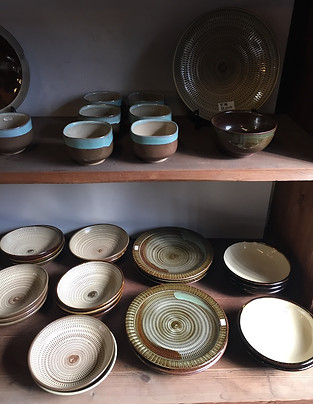
FUKUOKA - KOISHIWARA 東峰村 小石原村
Two distinct pottery styles have been co-existing in the village of Koishiwara since the1600s carrying different strategic objectives. How did that get started? We'd talked to Mr. Shinobu Takatori
(14th generation ceramists) to hear this interesting story. (Part 1 Video story here!)
WHY KOISHIWARA?
This is an ideal location for anyone who desires to investigate
wabi-tea ceremony (wabi-sabi) through Takatori tea vessels;
while mingle with the exoteric, nature-inspired, utility-driven Koishiwara ware.
TAKATORI
TAKATORI famliy is still actively producing high quality tea-wares. Master Hassen Takatori 高取八仙 (13th generation), Shinobu Takatori 高取忍 (14th generation) and Shuuichiro Takatori 高取周一郎 (15th generation) work relentlessly under one roof, to continue this 400 year old legacy, creating the most poetic and philosophical form of ceramics art.

13th generation Master Ceramist
Mr. Hassen Takatori 高取八仙 (84 years old)
TAKATORI-ware 高取焼
I’m a paragraph. Double click here or click Edit Text to add some text of your own or to change the font. This is the place for you to tell your site visitors a little bit about you and your services.
BACKGROUND
In 1600, when clan master Kuroda was dispatched to Korea, he brought back Korean potters who then set up kilns at the foothill of Hassan and Takatori. Straw ash and Ame glazed utilitarian tea-ware were produced.
During the 18th century, Tea Master Sen no Rikyu’s “wabi-cha” tea ceremony style gained popularity. Under the guidance of Tea Master Kobori Enshu, Takatori has prospered into a clan’s kiln. It was protected by the Kuroda clan to produce high quality tea ceremony tools for Generals and Feudal Lords. It has been named as one of “7 Famous Enshu’s Kiln”.
STYLE
Deep into the philosophy and teaching of wabi-sabi, Takatori-ware shows its mastery in wabi-style tea wares, not only in forms, but also in utilization of straw ash glaze, the deep-caramel “Ame” glaze and “Cho-sen" glaze to create abstract and poetic landscapes. In addition to the iconic cha-wan (Japanese tea bowls), Hassen Takatori is also reputable for its delicate ceramics tea canister.
Visit www.takatori.co.jp to see more Hassen Takatori Kiln's work.
Photo Courtesy of Hassen Takatori

KOISHIWARA
Carrying a long history in producing functional everyday-use earthenware, the key word to understand Koishiwara ware is 用の美 (yu no bi), "Beauty of Function".
This term was derived by Yanagi Muneyoshi during the "Mingei Movement" when he was touched by the simple beauty of these utilitarian earthenware.
Humble and heavy Koishiwara-ware adopted 5 signature white-slip and chattering decoration techniques, including “tobikanna” (jumping blade), “hakeme” (brush slip marking), “yubikaku” (finger combing), “nagashi kake”(drip marking), and “uchi kake” (splash-drip marking).

KOISHIWARA-ware 小石原焼
BACKGROUND
In 1682, under the rule of 3rd generation Kuroda clan master, porcelain potters from Imari were invited to the region to start producing pottery. Takatori was already established in the area (in 1600), and earthenware were called Agano-ware. For awhile it ceased production; not until early 18th century was it revived to produce utilitarian items including urns, bowls and pots.
In the early 1900s, it caught the attention of Muneyoshi Yanagi, while he was traveling the country, documenting folk crafts. Yanagi’s literary work pushed forward the “Mingei Movement”, stressing on the importance in preserving regional folk craft. Koishiwara-ware and neighboring Onta-ware left a deep impression on Yanagi’s research on the humble beauty of everyday-use earthenware. Thus arrived the term “Beauty of Function” (用の美)。As part of the Mingei Movement initiators, British ceramist Bernard Leach visited the area in the 1950s and stayed for 3 weeks exchanging skills and idea with local folk potters.
Currently, about 50 family kilns are still actively producing Koishiwara style earthenware, carrying the legacy of simplicity and “functional beauty”.

TAKETOMBO's THOUGHTS on KOISHIWARA
The more time I spent in Koishiwara (now known as Tohomura), the more I see the uniqueness of this hidden village.
With Takatori, as you start digging deeper, you will feel the endless layers of intelligence behind. It's very easy to engage in conversations with the masters and ended up concluding "it's very hard to explain...", "it's a bit beyond words". The symbolism, the poetic sensibility, the abstract expressionism, the zen buddhist philosophy... universe. It's about impermanence in life as well as life-long learnings.
Then 15 meters away, you'll walk into a Koishiwara studio, which grounded you back on planet Earth, talking about utilitarianism! During research, I was reading Yanagi's writings on Mingei (Folk Craft) Movement from the 1920s, it strikes me that his subject has never gone outdated. From how we are deceived by mass-produced cheap commodities, the importance of preserving quality craft culture, a country's cultural identity, user-experience... I can even relate this to Bauhaus' "timelessness" and "form follows function". Aren't these on-going subject matters for modern day designers as well?
Even more interesting experience is when you get to pick up works made by the artisans. Takatori-ware is rustic-looking but extremely delicate. Where Koishiwara is heavy and modest ( feels like an "ummmch" weigh-drop when you hold one in your hands). The tactility correlates to their history, function and philosophy.
And not to mention, these passionate masters show ultimate hospitality to anyone interested in learning about their craft and culture. I felt super lucky to have met them, to learn from them and to collaborate with them. I hope you would embark on this extraordinary journey of discovery as well.
-- Mikki from Taketombo

